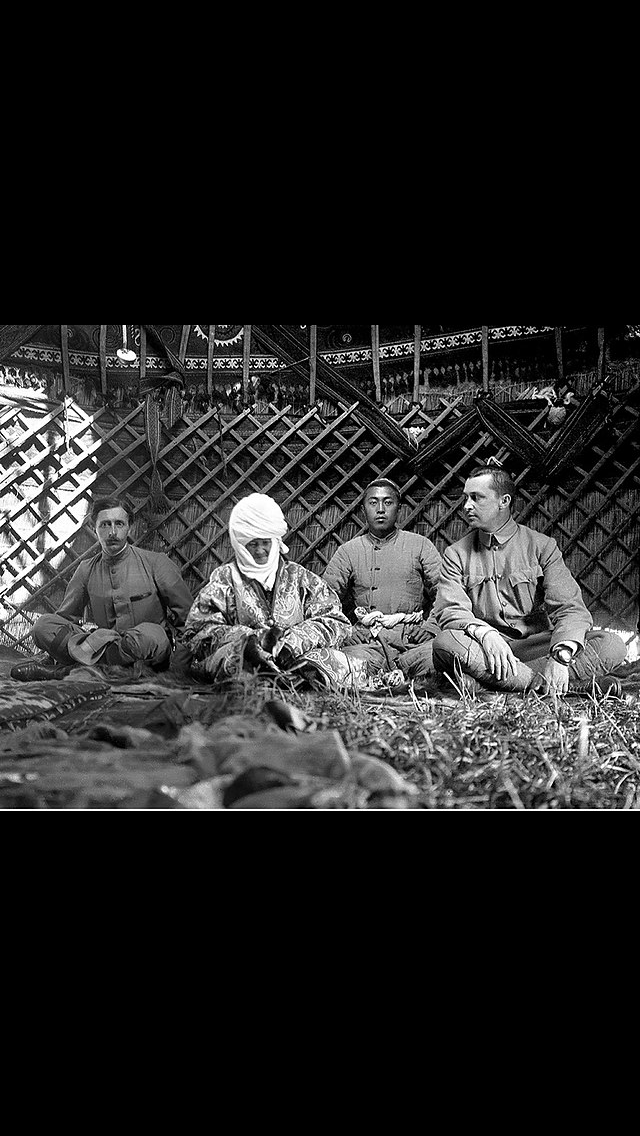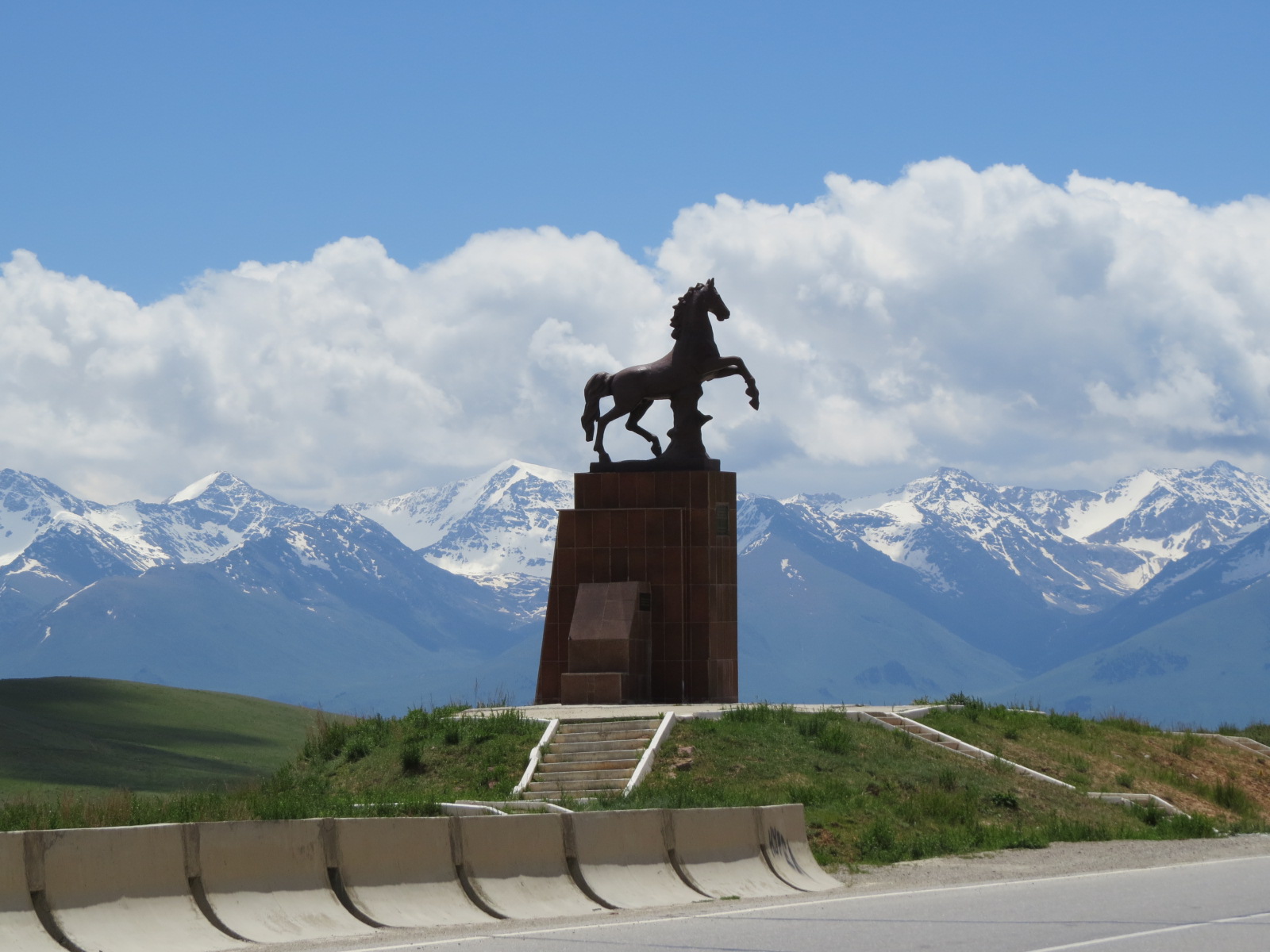Horses and Tash Rabat
However scrappy the towns in Kyrgyzstan, and Naryn being no exception, the beautiful valleys and hills around offered great solace. We were happy to be taken off to meet up with a guide and 3 horses (We had obtained a young translator to join us). The plan was to ride up the valley, gaining some 500m in height where there were views of the town and the surrounding mountains and then the plan was to descend in the neighbouring valley and stop off at a cave. This was to take most of the day and they provided a soggy sandwich at midday.
The horses were great but the equipment was very poor. The saddles were not in good condition and were hard on the rear and the stirrups were too short and had no adjustments and the reins were just bits of rope which had broken so many times that they were now too short to hold and sit upright! However, off we went. In the first half, most of the time we were climbing up. The unshod horses were accustomed to the challenge and puffed and panted ever upwards and needed very little encouragement from us to take on the task.
We stopped short of the top to take a break and admire the view. There were steep cliffs in front of us and steep banks everywhere else. We had to then climb the last 200m up a very steep bank and I had to avoid looking down and just trust the horse.
We had soggy sandwiches on top and admired the green and mountainous 360 degree views. Then we saw what we had to come down.
I was terrified to even walk down it, let alone sit on a horse and trust that it would not slip leaving me to roll hundreds of feet down. In the event my horse did not fancy it either and so the guide had to attach a leading rein - and I had to just trust. Too scared to photograph this!
Then looking back I realised that Jim nor our translator were descending this steep stretch either and I sent the guide back up for them too. I then had to sit alone on the horse on this track with this massive drop to my right till they had all descended. I was just willing the horse not to move until the guide returned and we gingerly crept forward in convoy.
This really scary stretch lasted about 20 minutes and although we had another few hours of steep descent, none felt so exposed.
To be fair even though we were beginning to ache and be sore as the day wore on, it was still a fantastic day with lovely horses that were fit and had no malicious streaks. We had so many trees to pass around or under and thorny bushes to negotiate, that these creatures could have had a field day, but they were patient and really just intent on not slipping themselves, as we descended steeply down rough tracks with massive gradients.
Halfway down the valley, we came across a couple of tents on a meadow surrounded by horses, cows and about a dozen pullets. We were asked if we wanted to approach the nomads and ask for tea. We were glad to get off the horses and to observe nomadic life at fairly close quarters.
Tea was whisked up swiftly and we were all offered some kind of unpasteurised cows milk which had been churned for hours and was then stored in rather grubby looking plastic bottles without refrigerators. I declined and Jim bravely drank a whole mug in a grubby plastic cup.
Then piles of freshly prepared bread came out of the smoking tent still warm and I am partial to the lightly fried variety of flat bread.
The family there that day when we visited were grandparents, probably a daughter-in-law and 5 children aged from about 10 to 18 months. They grazed their animals and just lived there all summer, cooking either outdoors or in their tent which had a chimney. They produced 40 litres of milk a day by four times daily milking of 4 small cows and I guess that this was an important part of their diet with bread. They had sacks of flour on site and tea.
Someone went down to the village once a week to pick up provisions on horseback as there were no cart tracks. They then gave away their surplus milk as they could not sell it being so far from civilisation. I guess some bartering went on with friends or neighbours.
We learnt that they came from a village lower down the valley and that when the weather turned they relocated back down to the village. I guess the tent was then erected in a yard alongside some family home. The older couple said that next year would be their last as they would be too old to make the journey and that their sons would take over bringing livestock up to the pastures.
After our snack we walked up to a cave located up above their camp in the cliffs. All the children decided to follow us up and much to my horror this included one that was just a baby and another who can’t have been more than three! Where the cliffs were too steep for little legs their sisters just hauled them up! I could not watch and just huffed and puffed my own way up the rocks till we were in the caves and the children swarmed over the edge and joined us quite quickly thereafter for the photocall.
Our limbs had had a welcome break from the saddles and we were now on the last hour or two of the journey as we plodded down the steep valley and through the woods and streams. We were all grateful to arrive safely at the bottom and to stagger to the waiting car. There were a few aches and bruises to show for our experience the following day and I doubt that we will be booking many horse rides on the rest of the trip! (Our last horse trekking adventure was on our honeymoon in Spain some 22 years ago!)
That evening Jim went off to see a film about about Kurmanjan Datka, seen as the mother of modern Kyrgyzstan. In 1906, when she was 95, she was photographed with Carl Mannerheim, seen as the father of modern Finland. Colonel Mannerheim is on the left and Ms Datka next to him.
From Naryn we drove along a very good road towards the border with China, where we could see the start of the Tien Shan range of mountains which separate Kyrgyzstan from China 🇨🇳.
Every village or settlement we passed had its own graveyard outside the village compound. All these graveyards are more elaborate than any Muslim graveyards we have seen in any other country. They seem more elaborate than the very homes people live in. This is just one of these sites and they are everywhere and often located in the most beautiful spots.
Our objective today, was to visit Tash Rabat which was another fairly remote caravanserai on the Silk Road from China. It was located up a valley off the main road and there were Yurt camps nearby where they served refreshments. Our plan was to sleep in Landy and to find a Yurt Camp meal.
Those who know Jim well will recognise that rarely does a statue pass that Jim does not stop to investigate. In Kyrgyzstan, this was becoming almost a full time occupation.
Along the newly built roads (Chinese funding and contractors), were dotted fine statues of erstwhile heroes in fighting poses. Jim decided that as these statues were largely new, that the country was trying hard to establish its national identity and history. Local people stopped to look at the statue and photos were taken.
(Note the hat, which is called a Kalpak. It is made of felt and is supposed to keep the head warm in winter and cool in summer. They mostly have patterns on them and are invariably black and white. What seems to change is the height. The taller hats denote the higher status of the wearer. You can probably pick one up for about £12. They are made by hand and worn by most men here.)
En route we tracked down the site of a massive fortress, Koshoy Korgon, located on the edge of a small village and dating back to 7th Century BC and supposedly built as a refuge for passing caravans and lonely strangers.
Story tellers would have it that it also became the home of Manas a legendary Kyrgyz nation builder and hero, much lauded for allegedly uniting disparate Kyrgyz tribes into one nation and fighting the Chinese invaders. He may not have existed, a bit like King Arthur, but the stories are an important part of Kyrgyz mythology.
The settlement later became a residence of the Turco-Mongol emperor, Amir Temur and his warriors.
We are told that it had been potentially a major capital city at some point. The historians live in hope that with investment that the site will become a major attraction.
You would be hard pushed recognise it as a fortress as it has not been restored at all, so much was left to the imagination or to the reproduction in the small museum nearby.
What is true is that is was very large as a site and unusually it was not located on a hill but on a very wide fertile plain with rivers and livestock grazing.
When we left, the weather in Naryn was bright and sunny but by the time we were approaching Tash Rabat dark clouds had formed over the mountains and heavy rain was forecast and it bucketed down on our approach to the Caravanserai. This country has bouts of heavy rain even in late June.
We found Tash Rabat and the rain had stopped but it was a grey evening and were not alone. There were a lot of Yurts and it was even on a local bus route that brought up small groups of local people in the dying light of the evening.
The Rabat was apparently fortified originally and was built in 10th Century as a medieval inn for the merchants and travellers on the Great Silk Road from Central Asia to China. The border with China is only 80kms away.
Apparently the massive stone walls and towers were supposed to be a monastery for Nestorian Christians or (Buddhists) before the Mongol invasion and the spread of Islam.
As the evening drew to a close and the sun was setting, a lorry drew up next to us with two dwellings in tow. Within the hour the new nomadic family had set up site opposite the monument, and were now in position for the summer!
We camped in Landy and ate in one of the Yurts and woke in brilliant sunshine in this totally beautiful valley overlooking the ancient caravanserai.
In the morning we continued on our journey back to Naryn and took with us 19 year old Zoe, a French student of Philosophy and Anthrolohy in Montpellier, who was travelling alone and hitchhiking.
Jim enjoyed discussing books and history with her and we dropped her off as we continued our way towards Bishkek.
That night we camped again in Landy, in an olive grove, hidden from the main road on the shores of a man-made lake. It was so peaceful. No dogs and no lorries!





















